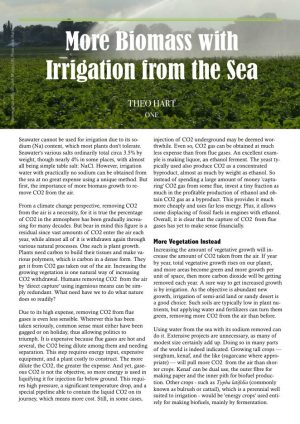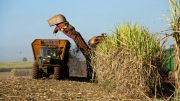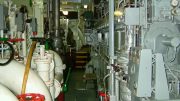 Seawater cannot be used for irrigation due to its sodium (Na) content, which most plants don’t tolerate. Seawater’s various salts ordinarily total circa 3.5% by weight, though nearly 4% in some places, with almost all being simple table salt: NaCl. However, irrigation water with practically no sodium can be obtained from the sea at no great expense using a unique method. But first, the importance of more biomass growth to remove CO2 from the air.
Seawater cannot be used for irrigation due to its sodium (Na) content, which most plants don’t tolerate. Seawater’s various salts ordinarily total circa 3.5% by weight, though nearly 4% in some places, with almost all being simple table salt: NaCl. However, irrigation water with practically no sodium can be obtained from the sea at no great expense using a unique method. But first, the importance of more biomass growth to remove CO2 from the air.
From a climate change perspective, removing CO2 from the air is a necessity, for it is true the percentage of CO2 in the atmosphere has been gradually increasing for many decades. But bear in mind this figure is a residual since vast amounts of CO2 enter the air each year, while almost all of it is withdrawn again through various natural processes. One such is plant growth. Plants need carbon to build their tissues and make various polymers, which is carbon in a dense form. They get it from CO2 gas taken out of the air. Increasing the growing vegetation is one natural way of increasing CO2 withdrawal. Humans removing CO2 from the air by ‘direct capture’ using ingenious means can be simply redundant. What need have we to do what nature does so readily?
Due to its high expense, removing CO2 from flue gases is even less sensible. Wherever this has been taken seriously, common sense must either have been gagged or on holiday, thus allowing politics to triumph. It is expensive because flue gases are hot and several, the CO2 being dilute among them and needing separation. This step requires energy input, expensive equipment, and a plant costly to construct. The more dilute the CO2, the greater the expense. And yet, gaseous CO2 is not the objective, so more energy is used in liquifying it for injection far below ground. This requires high pressure, a significant temperature drop, and a special pipeline able to contain the liquid CO2 on its journey, which means more cost.
Still, in some cases, injection of CO2 underground may be deemed worthwhile. Even so, CO2 gas can be obtained at much less expense than from flue gases. An excellent example is making liquor, an ethanol ferment. The yeast typically used also produce CO2 as a concentrated byproduct, almost as much by weight as ethanol. So instead of spending a large amount of money ‘capturing’ CO2 gas from some flue, invest a tiny fraction as much in the profitable production of ethanol and obtain CO2 gas as a byproduct. This provides it much more cheaply and uses far less energy. Plus, it allows some displacing of fossil fuels in engines with ethanol. Overall, it is clear that the capture of CO2 from flue gases has yet to make sense financially.
More Vegetation Instead
Increasing the amount of vegetative growth will increase the amount of CO2 taken from the air. If year by year, total vegetative growth rises on our planet, and more areas become green and more growth per unit of space, then more carbon dioxide will be getting removed each year. A sure way to get increased growth is by irrigation. As the objective is abundant new growth, irrigation of semi·arid land or sandy desert is a good choice. Such soils are typically low in plant nutrients, but applying water and fertilizers can turn them green, removing more CO2 from the air than before.
Using water from the sea with its sodium removed can do it. Extensive projects are unnecessary, as many of modest size certainly add up. Doing so in many parts of the world is indeed indicated. Growing tall crops — sorghum, kenaf, and the like (sugarcane where appropriate) — will pull more CO2 from the air than shorter crops. Kenaf can be dual use, the outer fibre for making paper and the inner pith for biofuel production. Other crops – such as Typha latifolia (commonly known as bulrush or cattail), which is a perennial well suited to irrigation – would be ‘energy crops’ used entirely for making biofuels, mainly by fermentation.
Sunroot (Helianthus tuberosis) is a type of sunflower with small tubers on its roots which grows tall and has many small flowers. It may be cut more than once as forage, which means it can also be fermented. The edible flower buds may be collected then. Since it regrows the following season from its roots, even the tubers may be harvested. Sterile hybrids exist which won’t propagate by seed. Of course, either confectionary or oilseed-type sunflowers could also be grown. Either can be decapitated early and the heads stored for dry down, with the stocks fermented to biofuels. Later, when the dry heads are threshed, that residue would be suitable for making furfural since both the pectin and xylans yield furfural. Maize cobs, either local or imported, would be another source of supply for the furfural maker, as can be chaff from wheat threshing. Furfural is only made from plant materials, often just maize cobs. A facility producing 5000 tons annually is usually profitable. Acetic acid is a byproduct.
Mediterranean countries grow durum wheat, yet most are also regular importers. Irrigation would provide reliable and greater output. Also, the straw and chaff from threshing can be fermented into biofuels. Part of the chaff could go instead to the furfural maker.
Tunisia
Tunisia is a small country in Africa about the size of England, with 1300 km of coast on the Mediterranean sea. Yet it has a chronic water shortage, made worse in the frequent drought years. The south of the country is an actual desert. The government has borrowed heavily to construct several desalination plants. The largest will have a daily output of 100,000 cubic metres and is being built some km from the city of Sfax on the south coast. Like most new plants anywhere, these use reverse osmosis to provide drinkable water. Priority is given to households and tourist centres, though much will go to irrigation. This is usual wherever irrigable land exists, and Tunisia has plenty. The water quality is much better than needed for this use.
Seawater is the input to these reverse osmosis plants, which convert less than half into drinkable water. The rest, now saltier, gets returned to the sea. Removing the sodium from this ‘reject water’ would allow it to be used for irrigation. Doing so would more than double the output of useable water from such a plant. As desalination plants are expensive, this would make a significant difference. One novel process to do it involves the use of imported potassium bicarbonate . A bit of technical detail here shows how this works. The critical thing is the low solubility of sodium’s bicarbonate, which is only ~10% by weight at circa 20 °C. Having it drop out of the saltier reject water rids it of sodium. Simply mixing with enough of potassium’s bicarbonate would do so, leaving a solution of the chloride of potassium (KCl), its usual fertilizer. However, there would be too much, about 12% by weight, so if possible this is best avoided. Using instead the bicarbonate of calcium should work, given a strong enough solution. According to a 2010 Australian patent, this bicarbonate may be made in good quantity from limestone, or other form of calcium carbonate, contacted with CO2, provided the material is finely ground and the water is neither alkaline nor acidic (neutral pH). Using the specified operating conditions it claims a solution of about 16% by weight calcium bicarbonate can be built up. Mixing this with ‘reject water’ will likewise remove its sodium as bicarbonate, while creating calcium chloride which remains in solution. This should be fine for irrigation diluted with fresh water, at least for some crops. It would be best to lower the chloride content, of course, but that is a separate issue.
Use of Irrigation Water
Large fields of durum need large equipment; smaller fields with equipment suited to them will do instead. This means more farms and more local employment to serve families. Suitable equipment for this size of farm is made in Italy, among other places — a reaper bundler for harvesting in particular. Say a farmer has 16 to 20 hectares in durum and with irrigation gets a yield of 3 t/ha. That’s 48 to 60 tons of grain, and a decent income at 300 €/t.
Twenty thousand farms of this size could supply a million tons or more of durum. Tunisia currently imports at least that much and more. That is only the grain. More income could come from selling straw and chaff to those who ferment it to produce biofuels. Of course, their main supply of fermentables would come from farmers specifically growing crops for that purpose. Many biofuels would be made, for furnaces, cook stoves, heaters, grills, and particularly for external combustion engines of all sizes once they become widely available. Ethanol is not a good fuel compared with some others. The EU is a good market for biofuels. Biofuel bonds could be used to raise money.
Vine crops would also be cash crops, such things as melons and squash, mostly for export. In order to conserve irrigation water, the plants would best be rooted in raised beds while their vines are tied to linear supports over dry ground, perhaps even uphill. Harvesting requires no stooping. Each bed is separate and the ground need not be level. Since water is applied to the top of the bed and drains down, this should keep sodium salt from staying in the root zone. Such crops produce a large amount in a small area and need close attention, so the size of the farm would be a few hectares each.
Theo Hart




